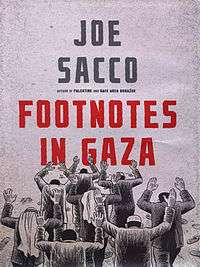Footnotes in Gaza
 | |
| Author | Joe Sacco |
|---|---|
| Illustrator | Joe Sacco |
| Country | United States |
| Language | English |
| Subject | Rafah, Suez War |
| Genre | Comics, New journalism |
| Publisher | Jonathan Cape |
Publication date | 2009 |
| Media type | Print, Paperback |
| Pages | 418 |
| ISBN | 0-8050-7347-7 |
Footnotes in Gaza is a journalistic graphic novel by Joe Sacco about two bloody incidents during the Suez Crisis. It was published in 2009.
The book describes the author's quest to get to the bottom of what happened in Khan Younis and in Rafah in the Gaza Strip in November 1956. According to United Nations figures quoted in the book, Israeli forces killed 275 Palestinians in Khan Yunis on 3 November 1956 and 111 in Rafah on 12 November 1956.
Sacco bases his book on conversations with Palestinians in Rafah and the neighbouring town of Khan Younis, and interweaves the events of 1956 with the events in Rafah at the time of the interviews—the bulldozing of homes, the death of Rachel Corrie and the reactions to the outbreak of the Iraq War.
In a special report by the local UNRWA director, covering the period from November 1 through mid-December, and submitted to the UN General Assembly on 11 January 1957. According to this report, on 3 November, during the conquest of Khan Yunis, Israeli forces killed 275 Palestinians: 140 refugees and 135 local residents. On 12 November (after the fighting was over), Israeli military forces killed 110 Palestinians in Rafah: 103 refugees, seven local residents, plus one Egyptian.[1]
Official and other sources are quoted in full in the graphic novel, published in 2009 by Henry Holt and Company. "Footnotes in Gaza," by comics journalist Joe Sacco, is a hefty, album-sized tome whose hard-cover version is 418 pages long - 388 of which are covered with meticulous and highly detailed black-and-white illustrations depicting Sacco's journeys to Khan Yunis and Rafah (and Jerusalem) to investigate these unknown atrocities, and his interpretation in graphic-novel form of the testimonies he collected from dozens of people.
Awards
- 2009 Los Angeles Times Book Prize Graphic Novel Finalist
- 2010 Ridenhour Book Prize
- 2010 Eisner Award for Best Writer/Artist–Nonfiction
- 2012 Oregon Book Award: Pacific Northwest College of Art Graphic Literature Award
Publication
- Sacco, Joe (2009). Footnotes in Gaza, Jonathan Cape, ISBN 0-8050-7347-7. Jonathan Cape, ISBN 0-224-07109-2.
Review
The New York Times book Review quotes "Joe Sacco's brilliant, excruciating books of war reportage are potent territory....He shows how much that is crucial to our lives a book can hold"[2]Rachel Cooke called it 'truly unique' in 'combining as it does oral history, memoir and reportage with cartoons in a way that, when he started out, most people – himself included, at times – considered utterly preposterous.'[3]
Publishers Weekly says, "Having already established his reputation as the world’s leading comics journalist, Sacco is now making a serious case to be considered one of the world’s top journalists, period. His newest undertaking is a bracing quest to uncover the truth about what happened in two Gaza Strip towns in 1956… Sacco’s art is alternately epic and intimate, but it’s his exacting and harrowing interviews that make this book an invaluable and wrenching piece of journalism.”
References
- ↑ A thin black line. Haaretz.com.
- ↑ Patrick Cockburn, ‘They Planted Hatred in Our Hearts,’ New York Times, 24 December, 2009
- ↑ Rachel Cooke, Eyeless in Gaza, The Guardian 22 November 2009
Further reading
- Chute, Hillary (2016). Disaster Drawn: Visual Witness, Comics, and Documentary Form. Harvard University Press. ISBN 9780674504516.